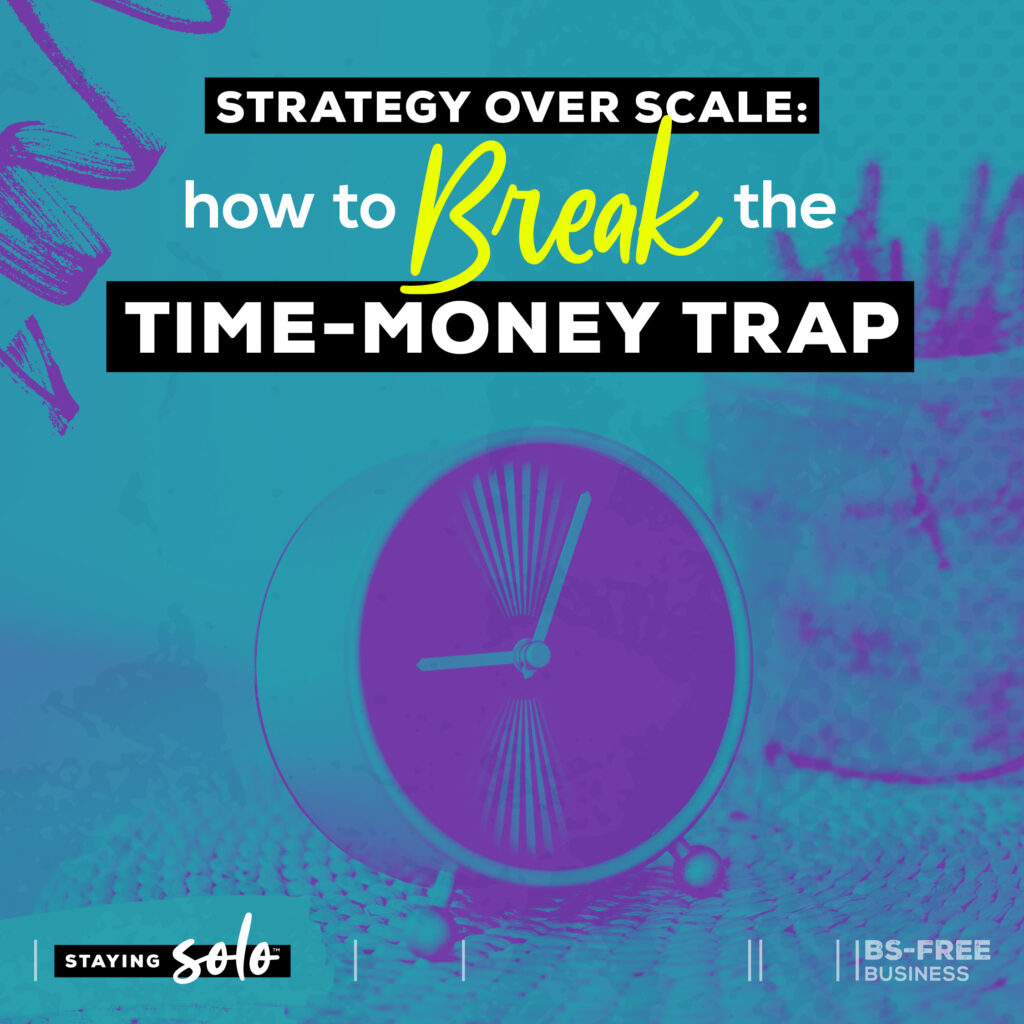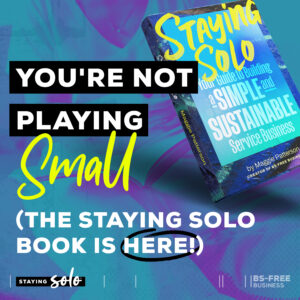
Search the site:
Strategy Over Scale: How to Break the Time vs Money Trap
Every solo service business owner knows the pressure to do more to earn more—but what if that’s a trap?
In this episode, I’m breaking down the myth of scaling and showing you how to use strategy to grow your business without burning out.
If you’re tired of feeling stuck between working harder or like you need to settle for staying stagnant, this episode is for you. Let’s face it: growing a business as a solo service business owner means you can’t just add more and more to your plate.
When you choose to stay solo as a service business owner at some point, you’ll grapple with the fact that you only have so much time and energy and can’t just do more to make more money. This creates a dilemma as you’re torn between having to work more or not being able to make more money, neither of which is a desirable option.
The good news is that while this dilemma exists, you don’t need to accept it as an inevitable reality for your business. The key is figuring out how to leverage the pillars of the Staying Solo Framework to free up your time while being able to make more money.
The Scam of Scaling: Embrace Leverage Instead
Conventional business wisdom from celebrity entrepreneurs is that your goal should be to scale your business. (And, of course, they’re the ones who will teach you how to do it!)
The problem with these teachings about scaling is that most businesses, especially service-based ones, aren’t built for scaling. Scaling is a nightmare scenario for many businesses as it dramatically increases “output” without increasing costs or adding resources.
Pursuing profit drives scale and is often done at the expense of the people involved, which I’m pretty sure most of you want no part of. (Which is why you’re listening to this podcast!)
Instead of scale, I want to discuss something much more sustainable and will help you break out of the time/money trap: leverage.
I’ve talked extensively about the Staying Solo Framework, and now it’s time to revisit the three pillars that can be used as levers to help you grow in a way that won’t burn you or make you want to burn everything down — Strategy, Salary and Space.
Over the next three episodes, I’ll share essentially the “graduate school” level for these pillars.
You take these actions once you’re in a position where you’re looking to answer the question, “What’s next?” in your business, and you know it’s not just about working more, hiring, or launching a course. Or when you feel burnt out or bored by your business, everything you consider doing feels like a circle or triangle jammed into a square hole.
These levers are nuanced and should be individualized to your business situation.
I’m a big believer that there’s no one-size-fits-all, particularly once you’re at a certain point in your business. I’ll do my best to guide you on what to think about with each one and what you can consider putting into action in your business.
Breaking Through the Income Ceiling: Strategic Moves for Solo Growth
Remember when I talked about the time/money dilemma earlier? That often shows up as an income ceiling where you simply can’t work anymore, but as a result, you don’t feel like you can make any more money.
Your revenue stagnates, impacting how much you can pay yourself and how you feel about your business. Stable income is wonderful, but not if you want (or need) to make more, so you feel frustrated or resentful.
The strategy pillar of the Staying Solo Framework is designed to help you break through the revenue ceiling. This type of ceiling can happen at any stage of your business, but for this discussion, I want to look at your options when it’s not simply raising your prices or doing a little more marketing.
I’m talking about a situation where you’re stuck and struggling to figure out precisely what to do next. You know something needs to change, so you’re not working so much but can make more money.
The good news is everything I’m going to share with you is meant to refine what you’re already doing and can be done in a way that ensures you’re not just adding more work to your plate.
Upgrading Your Overall Business Strategy
When I say overall business strategy, I’m not talking about burning everything down and starting from scratch. You know what you’ve got right now works, but you need things to work better. You need it to be simpler, more sustainable, and enable you to make more money.
Your overall business strategy is layered, but these three areas always have room for fine-tuning: your industry, core client, and value proposition. All three areas have a tangible impact on how much you can charge for your services and how you work with your clients.
Each one of these areas could be an episode on its own, but here’s what to consider for each.
Target Market
The industry your clients are in impacts how much they’ll pay for your services and what they expect in return. If you suspect your target market is a factor, consider what other industries you have experience in or which ones are closely related and would be a good fit. Just because you’ve worked in one industry for a few years doesn’t mean you can’t work in another successfully.
Core Client
Beyond the industry, there’s who actually buys your services. What’s their role and experience? What are their pain points? I see many service business owners who get this one wrong and don’t tailor their messaging, marketing, and, most of all, their services to the actual potential client. You need to be as specific as possible about their challenges and how you can best serve them. If everyone is your potential client, no one is.
Value Proposition
Why should a client choose to work with you? You’re limiting yourself if you can’t clearly and convincingly share that through your sales and marketing. This isn’t a nice to have. This becomes table stakes at a certain point in your business as it can easily cut you off from potential clients. Take the time to clarify your skills, experience, successes, how you’re different and the problems you solve based on how your business operates today, not two years ago.
Remix Your Delivery Model
Let’s move on to your delivery model—how you deliver your client services. Please note: These aren’t your packages (which I’ll talk about in a sec) but rather the way you deliver services such as projects, retainers, or intensives.
Your delivery model is a strategic lever. Usually, you’ll find one way of working with our clients and stick with that. That’s not to say that only doing project work or long-term retainers is bad, but getting into a rut is easy. Not every service or client will fit into the delivery model you’ve always used.
For example, you’ve been doing project-based work, and your average client engagement takes three to four months. That can be all-consuming and potentially draining.
What if you could deliver other services to existing clients with a retainer or a 90-minute intensive? Diversifying your revenue isn’t just about adding so-called “passive” income. It can also be about delivering different types of services in various ways.
For some of you, this may be exactly what you need to breathe new life into your business. There’s always room for experimentation with how you deliver your services. (And if this isn’t for you, remember there are many strategy levers at your disposal. Not every one of these will work for everyone.)
Simplify and Sell: Packaging Strategy
If you’re at the point in your business where you’re feeling stuck, you probably already have packages in place. But here’s the thing: having packages will only get you so far.
There comes a time when you need to refresh your packages and simplify everything to make them more profitable. Take a look at your existing packages and audit what’s included. You’ll likely find that there are things you can remove which will save you time and make the package work harder for you.
The most significant missed opportunity with packages is alignment with the client’s problem. The tighter alignment with the actual problem and their level of awareness of the situation, the easier it will be to sell, and the more you can charge for it.
Finally, you need to sell the strategy. I’ve discussed this in detail in many past episodes, but this is the best way to position yourself as an expert and get paid well. For many of my clients, this is a turning point in their business as they’re making more money and not working so damn hard.
The Power of Precision: Choosing the Right Levers
As we wrap up, please know that the key with these levers is to pick and choose based on what’s most suitable for you and your business. (To explore this further, check out the Breaking Free from the Time vs. Money Trap video here.)
There’s nuance to these levers, which goes far beyond what I can share in a podcast episode. The beauty here is that relatively small changes can have an impact. When your business reaches a certain level of maturity, having the right strategy at the right time can help you break through the income ceiling.
There’s one final strategy, which I’ll discuss in detail next week when we examine the salary pillar of the Staying Solo framework:— pricing.
Although pricing is a powerful tool, it’s often the go-to lever for most service providers—and the one that can quickly get you caught up in overthinking, so it needs a deeper discussion related to your overall money management and mindset.
In that episode, I’ll debunk one of the biggest money management myths that messes with solo business owners.

I’m Maggie Patterson (she/her), and services businesses are my business.
I have 20+ years of experience with client services, am a consultant for agency owners, creatives, and consultants, and vocal advocate for humane business practices rooted in empathy, respect, and trust.
Read or Listen to the Latest
Check Out These Posts
For Solo Business Owners

Growing a solo service business is tough.
It’s even harder when you’re bombarded with BS advice that steers you away from your values and why you started your business in the first place.
This is the podcast for solo creatives and consultants who want to remain as a team of one and have zero interest in the hustle and grind of typical business teachings.
Subscribe now and never miss an episode.
For Micro Agency Owners
Most podcasts for agency owners obsess over revenue growth as the ultimate success metric.

But here’s the truth: not everyone wants to make millions. Your goal might be to build a sustainable business that lets you have a life and doesn’t run you into the ground.
Join me as I spill my shameless confessions and share everything I’ve learned about building a micro agency that skips the BS of tired and typical agency teachings.
Follow Now on All Major Podcast Platforms








